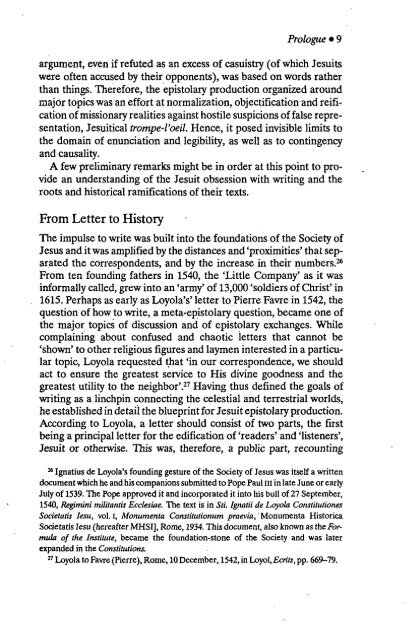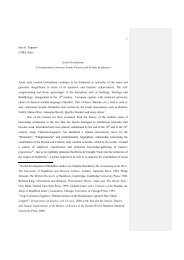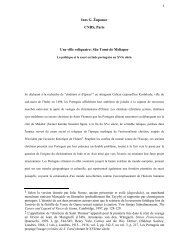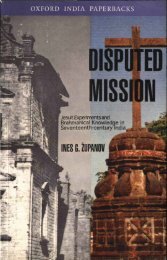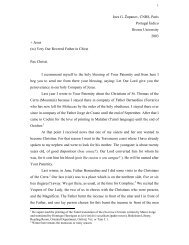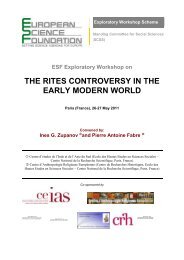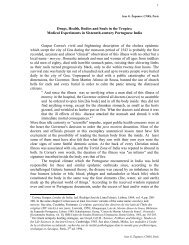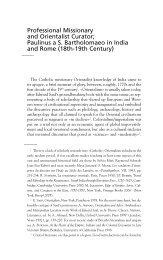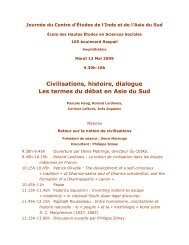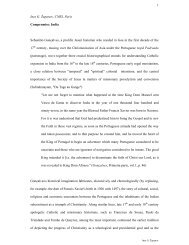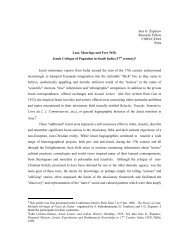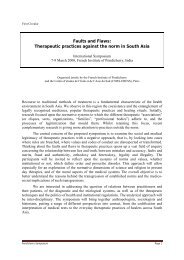INES G. ZUPANOV - Ines G. Županov
INES G. ZUPANOV - Ines G. Županov
INES G. ZUPANOV - Ines G. Županov
You also want an ePaper? Increase the reach of your titles
YUMPU automatically turns print PDFs into web optimized ePapers that Google loves.
Prologue • 9<br />
argument, even if refuted as an excess of casuistry (of which Jesuits<br />
were often accused by their opponents), was based on words rather<br />
than things. Therefore, the epistolary production organized around<br />
major topics was an effort at normalization, objectification and reification<br />
of missionary realities against hostile suspicions of false representation,<br />
Jesuitical trompe-l'oeil. Hence, it posed invisible limits to<br />
the domain of enunciation and legibility, as well as to contingency<br />
and causality.<br />
A few preliminary remarks might be in order at this point to provide<br />
an understanding of the Jesuit obsession with writing and the<br />
roots and historical ramifications of their texts.<br />
From Letter to History<br />
The impulse to write was built into the foundations of the Society of<br />
Jesus and it was amplified by the distances and 'proximities' that separated<br />
the correspondents, and by the increase in their numbers. 2 *<br />
From ten founding fathers in 1540, the 'Little Company' as it was<br />
informally called, grew into an 'army' of 13,000 'soldiers of Christ' in<br />
1615. Perhaps as early as Loyola's' letter to Pierre Favre in 1542, the<br />
question of how to write, a meta-epistolary question, became one of<br />
the major topics of discussion and of epistolary exchanges. While<br />
complaining about confused and chaotic letters that cannot be<br />
'shown' to other religious figures and laymen interested in a particular<br />
topic, Loyola requested that 'in our correspondence, we should<br />
act to ensure the greatest service to His divine goodness and the<br />
greatest utility to the neighbor'. 27 Having thus defined the goals of<br />
writing as a linchpin connecting the celestial and terrestrial worlds,<br />
he established in detail the blueprint for Jesuit epistolary production.<br />
According to Loyola, a letter should consist of two parts, the first<br />
being a principal letter for the edification of'readers' and 'listeners',<br />
Jesuit or otherwise. This was, therefore, a public part, recounting<br />
26 Ignatius de Loyola's founding gesture of the Society of Jesus was itself a written<br />
document which he and his companions submitted to Pope Paul m in late June or early<br />
July of 1539. The Pope approved it and incorporated it into his bull of 27 September,<br />
1540, Regimini militantis Ecclesiae. The text is in Sti. Ignatii de Loyola Conslitutiones<br />
Societatis lesu, vol. I, Monumenta Constitutionum praevia, Monumenta Histórica<br />
Societatis lesu (hereafter MHSI], Rome, 1934. This document, also known as the Formula<br />
of the institute, became the foundation-stone of the Society and was later<br />
expanded in the Constitutions.<br />
27 Loyola to Favre (Pierre), Rome, 10 December, 1542, in Loyol, .Ecrite, pp. 669-79.


